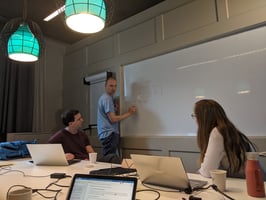Getting a complex product to market fast and without error is critical for manufacturers. But when...
Tacton Studio modeling
Modeling with Tacton Studio is a powerful tool for creating effective and efficient configurators for complex products and systems. It allows you to define the various components and their relationships, as well as set up rules and constraints to guide the configuration process.
One of the key benefits of using Tacton Studio is the ability to define classes, components, and parts. A class is a blueprint for a component, describing it's features. A component is a specific instance of a class. A hierarchical structure allows you to easily organize and manage the various components within your product.
In addition to defining the structure of your product, Tacton Studio also allows you to set up rules and constraints to guide the configuration process. These constraints can be used to ensure that the final configuration is valid and meets the necessary requirements. For example, you may want to ensure that certain components are only included if certain conditions are met, or that certain combinations of components are not allowed.
Another important feature of Tacton Studio is the ability to use search strategies and scenarios to further refine the configuration process. Search strategies allow you to define the order in which the configurator should try different combinations of components, while scenarios allow you to define specific combinations of components that should be used in certain situations. This allows you to create configurators that are more tailored to the needs of your customers.
By taking advantage of these features, you can create configurators that are more efficient, accurate, and user-friendly, ultimately leading to a better experience for your customers.
cpq.se modeling training
The modeling tutorial from cpq.se is a series of lessons that teach users how to use Tacton Studio, a software tool for creating configurators and product selection systems. The tutorial covers a range of topics, including creating a part structure, setting up questions for users, adding constraints to ensure that only valid product combinations can be selected, and creating scenarios to describe rules for product selection.
The tutorial also covers advanced topics such as adding search strategies to guide the configurator in finding solutions, and adding named domains to provide predefined lists of values for attributes. The tutorial is designed to provide a comprehensive understanding of how to use Tacton Studio to create configurators and product selection systems.
The basic concepts
The modeling tutorial from cpq.se provides a comprehensive overview of the methodology used for creating and solving configuration problems with Tacton Studio. The tutorial covers a wide range of topics, including defining classes and components, creating questions and groups, setting up search strategies, using constraints to solve configuration problems, and adding scenarios to describe complex rules.
A class in Tacton modeling refers to a type of component that can be used to build a product or service. It represents a set of properties and behaviors that are shared by all instances of the class.
A component is a specific instance of a class that has been customized for a particular product or service. It represents a unique combination of features and options that has been selected for a particular configuration.
A part is a physical object or component that is used to build a product or service. It represents a tangible item that can be manufactured or purchased.
A step in Tacton modeling refers to a specific point in the configuration process where the user is asked to make a choice or provide input. It represents a decision or action that the user must take in order to complete the configuration.
A group in Tacton modeling refers to a set of related questions or steps that are presented to the user as a single unit. It allows the user to see all of the relevant options and constraints at once, and make informed decisions about their configuration.
Search strategies in Tacton modeling refer to the algorithms and approaches that are used to find solutions to the configuration problem. They determine the order in which the configurator considers different options and combinations, and can be customized to suit the needs of the product or service being configured.
Scenarios in Tacton modeling refer to specific sets of rules and constraints that apply to certain situations or configurations. They allow the configurator to make intelligent decisions based on the context of the configuration, and can help to ensure that the final configuration meets all of the necessary requirements and constraints.
Conclusion
You will learn what makes up a model, including classes, parts, groups, questions, and steps. You'll also seen how to use constraints to define rules and logic for our models, and how search strategies and scenarios can help us to add defaults and describe complex rules more efficiently.
Using Tacton Studio to model your products allows you to create more intuitive and efficient configurators that can help your customers to quickly and easily find the best products for their needs. So if you're interested in learning more about modeling with Tacton Studio, be sure to check out the resources available on cpq.se.
Use the button above to book a meeting with Magnus and Patrik to find out more (or use this link).




